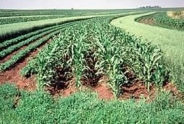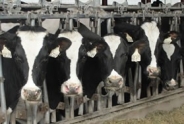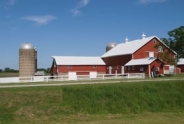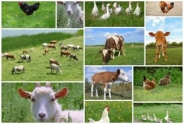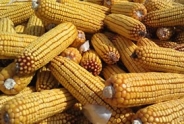Tips for Avoiding Copper Toxicity in Sheep
Amy Barkley, Livestock Specialist
Southwest New York Dairy, Livestock and Field Crops Program
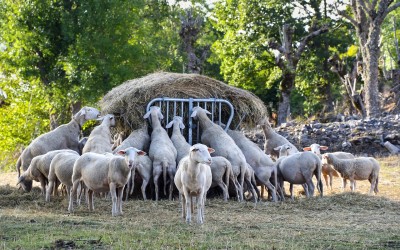
Tips for Avoiding Copper Toxicity in Sheep
By Amy Barkley, Livestock Specialist
Copper is a micromineral required for normal body functions in animals. It's also used as a medicinal tool for some conditions, such as parasite treatments and hoof scald. However, around sheep, it should always be used with caution. Copper is only needed in very small amounts by sheep, and overconsumption can lead to toxicity issues. The nutrient is stored in the liver and kidneys where it can build up to toxic levels over time. It can be released into the bloodstream in response to a stressful event such as shearing, transport, or running the animals through a chute, which can cause serious medical conditions, including death.
For most sheep, feeding a balanced mineral designed for them will provide the right amount of copper in addition to a forage-based diet to not have to worry about improper supplementing. However, there are some circumstances when you should be considering copper concentrations in the diet more closely.
So, How Much Copper do Sheep Need, Anyway?
Sheep need around 4-6ppm (parts per million) of copper, when looking at a diet from a dry matter perspective. This is the bare minimum to prevent deficiency. Typically, 8-11ppm is fed, and this is OK for most animals. The ppm value is calculated from the sum of copper consumption from forage, concentrate feeds, and supplements.
What do I need to watch out for?
1.) Minerals designed for other species
Species other than sheep are not as sensitive to copper, and have higher tolerances and physiological needs. Supplemental minerals for these animals have copper levels that are often too high for sheep. In the Northeast, salt supplements for sheep should be fed separate from minerals, and those salts should have no copper added. That way, the sheep can consume the salt they'd like without chancing toxicity.
2.) Concentrates
For sheep being supplemented with grain, make sure that the grain formula is designed for sheep and that the sheep are not overconsuming it. This is especially important for dairy sheep because they need a higher level of concentrates in their diet to produce optimally. Review the copper concentrations on your grain labels and make sure that your sheep are getting no more than they can tolerate.
If you are mixing your own concentrate, check the nutritional values of the feedstuffs you are mixing together, especially soybean meal and corn distillers grains, which are naturally high in copper. To check these values, you can have your feed tested through an accredited laboratory, or you can reference the Dairy One Feed Composition Library to see average copper values for each kind.
3.) Grass Exposed to High Copper Fertilization
Poultry and swine manures can have a disproportionally high level of copper in them because poultry and swine diets sometimes contain copper as a growth promoter or feed additive. The higher levels of copper can be taken up by forages. There are some management strategies to consider if you use either of these manures. First, allow time between the application of manure and letting sheep graze on the fertilized pastures to reduce the chance of sheep ingesting the manure. Second, know that repeated applications of poultry or swine manure over multiple years can make the potential for toxicity greater. The way to alleviate high copper soils resulting from fertilizing is to add Molybdenum (Mo) at the same time or liming to a pH where the copper won't be absorbed as much by the plants. This pH is greater than 7, and difficult to achieve in SWNY soils. Testing the soil copper levels in forages in fields where these manures have been applied before grazing or feeding is good insurance.
4.) Diets that are too low in Molybdenum and Sulfates
Molybdenum is a copper agonist, meaning that it reduces the copper absorption. Sulfates create a copper substance called "copper thi-molybdate" in the rumen, which doesn't allow the copper to be absorbed by the body. These minerals are needed in the correct proportion with copper to help reduce the chance of toxicity. The dietary Cu:Mo should be 6:1 to 10:1. Some forage-based diets can have forages that don't have this proper ratio. This is another reason why we recommend getting your forages tested!
5.) Water Treatments and Footbaths
Copper sulfate is commonly used for treating drinking water to lessen algal growth. Water treated with copper sulfate should not be provided to sheep. This substance is also used in footbaths and is highly toxic because of the levels used. Sheep should not be allowed access to footbath solutions containing copper sulfate. Furthermore, forage that grows where footbaths have been dumped previously should not be fed to sheep, as they have a good chance of containing toxic levels of copper.
Resources and Further Reading:
Dr. Mary Smith, Chronic Copper Poisoning in Sheep. block 5
Suttle, N.F., 2012. Control of hepatic copper retention in Texel ram lambs by dietary supplementation with copper antagonists followed by a copper depletion regimen. Animal Feed Science and Technology. 173, 194-200.
Upcoming Events
WNY Pastureland Conversion & Soil Health Field Day
July 16, 2025
Middleport, NY
Join American Farmland Trust for the Western New York Soil Health Field Day on July 16, 2025, at Zeliff Farm in Middleport, NY, from 9:00 AM-3:15 PM. Learn about pasture conversion, soil health benchmarking, biochar in grazing systems, and best grazing practices. Plus, enjoy hands-on demos with the NY Soil Health Trailer, drones, and cover crops! Check out the attached agenda for more information about the field day and REGISTER HERE. Zeliff Farms is a regenerative beef operation who has recently partnered with AFT on outreach and education to farmers including learning circles and evaluating biochar effects on soil health.
IPM Strategies to Protect Corn and Soybean Seed in NY
July 30, 2025
Hamburg , NY
SWNYDLFC and Cornell IPM are hosting a grower meeting to discuss integrated pest management strategies for protecting corn and soybean seed in New York.
FAMACHA Training for Sheep and Goat producers in Woodhull NY
August 13, 2025 : FAMACHA Training in Woodhull
Woodhull, NY
Join us for a discussion and hands-on training for internal parasite integrated pest management in sheep and goats. Certification is available to all students participating in the workshop.
Announcements
No announcements at this time.

